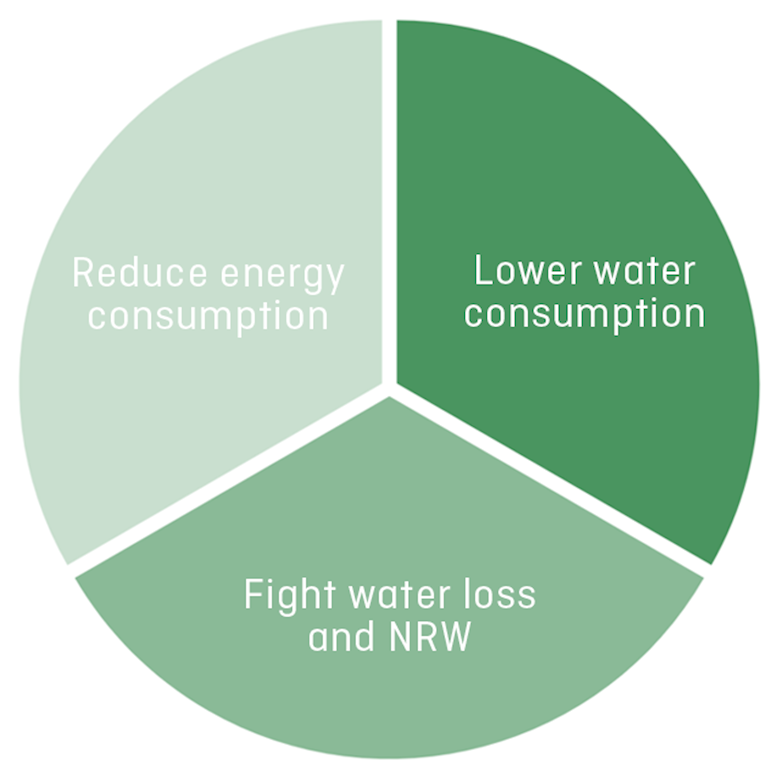Posted on Tuesday, April 23, 2019 by Martin Møller Værum
The Green Opportunities with Smart Metering - Part 3
Three ways today’s technology can deliver bottom-line results and a sustainable water future
Three ways today’s technology can deliver bottom-line results and a sustainable water future
Conservation and sustainability are on everybody’s lips these days. But with water loss and aging infrastructures growing into major concerns, we shouldn’t just talk about a sustainable water future. It requires action today. Too much drinking water disappears on the way to the consumers or is consumed without being metered, which makes it difficult for utilities to know when and where to take action.
Conservation and sustainability are on everybody’s lips these days. But with water loss and aging infrastructures growing into major concerns, we shouldn’t just talk about a sustainable water future. It requires action today. Too much drinking water disappears on the way to the consumers or is consumed without being metered, which makes it difficult for utilities to know when and where to take action.
Intelligent meters, remote reading, and advanced analytics offer more than accurate and fair billing. While contributing to black bottom lines and optimisations within operations, customer relations and asset management, they also bring a triad of green opportunities such as lowering water consumption, fighting Non-Revenue Water and reducing energy consumption.
In this blog series we want to dive deeper into those win-win green opportunities to explore what concrete results can be achieved already today for a bright sustainable water future. In the first part we will look into the role of end consumer awareness in lowering consumption.
Part III Reducing energy consumption with pressure optimisation
In this third and final part of the green opportunities series, we are touching on the possibilities of reducing energy consumption and CO2 emissions by optimizing the pressure in your network.
Reducing energy consumption with pressure optimisation
When water is distributed at a pressure that is higher than it needs to be, the energy consumption of the pumps is also unnecessarily high. In addition, it increases the water loss due to leakages from cracks in the pipes. However, if the pressure too low at the point of supply, consumers will experience an insufficient water pressure and it will also increase the risk of water ingress from the surrounding environment, which can pollute the drinking water.
Continuously monitoring the pressure in their distribution network allows water utilities to adjust their supply according to the actual demand throughout the day rather than always basing it on the pressure required at peak times. This enables them to significantly lower the energy consumption of their pumps without compromising on the ideal comfort level for their customers.
Pressure management results in less energy consumption as well as fewer bursts, less stress on pipes, fewer leaks, greater comfort level for consumers and better water quality.
Pressure optimization also reduces the number and volume of leaks in the distribution network and allows faster detection of the damaging pressure surges that stress the pipes. As a result, pressure optimization is also highly relevant for a utility’s asset management, as repairing and replacing poor performing pipes are among the most cost-heavy areas for most water utilities. In addition to the cost of materials, there are also significant costs associated with the excavation of streets, re-routing traffic and re-establishing infrastructure.
By lowering the pressure and thereby limiting the number of pressure surges, a utility can prolong the lifetime of the distribution network. Also, the oldest pipes may not necessarily be the ones that are in the worst condition. Therefore, the more parameters (e.g. the pipes’ age, pressure effects, flow temperature, etc.) that are included in the asset management analysis, the more precise the mapping of the state of the distribution mains will be. Smart metering makes many of these parameters automatically available so that utilities are able to assess which areas must be renovated first and which investments can be postponed.
The case
In the Danish town Skanderborg intelligent water solutions provided energy saving of 15%. Real-time data collection provided the utility with a clearer picture of the water consumption. This allowed to optimize the supply and reduce the energy consumption and, as a result, also the CO2 emission. “In total, we have been able to reduce the energy consumption by 15 percent at our largest water utility. On a nationwide scale, the total energy savings equal a medium-sized Danish city," CEO, Jens Bastrup, from Skanderborg Utility.


